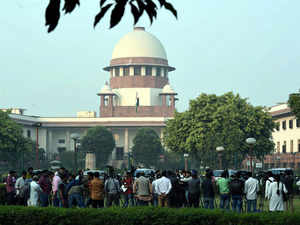 PTI
PTIThe right of citizens to protest would have to yield to the right of others to move freely, said a bench of Justices Sanjay Kishan Kaul, Aniruddha Bose and Krishna Murari. The ruling came on a plea of lawyer Amit Sahni who wanted the Shaheen Bagh protesters evicted as they blocked the road and created traffic chaos in the city.
The state must deal with protests sensitively, initiate a dialogue with protesters and not let them go out of hand, the court said. In case protesters squat on public places, the police must evict them without looking for a court order, the bench said.
“While appreciating the existence of the right to peaceful protest against a legislation (keeping in mind words of Pulitzer winner Walter Lippmann, who said ‘In a democracy, the opposition is not only tolerated as constitutional, but must be maintained because it is indispensable’), we have to make it unequivocally clear that public ways and public spaces cannot be occupied in such a manner and that too indefinitely,” the court said.
Lok Sabha Elections#Elections With 
- All
- Uttar Pradesh
- Maharashtra
- Tamil Nadu
- West Bengal
- Bihar
- Karnataka
- Andhra Pradesh
- Telangana
- Kerala
- Madhya Pradesh
- Rajasthan
- Delhi
- Other States
“Democracy and dissent go hand in hand, but then the demonstrations expressing dissent have to be in designated places alone. The present case was not even one of protests taking place in an undesignated area, but was a blockage of a public way which caused grave inconvenience to commuters.”
The plea that an indeterminable number of people can assemble whenever they choose to protest cannot be accepted, the court said.
“We have, thus, no hesitation in concluding that such kind of occupation of public ways, whether at the site in question or anywhere else for protests is not acceptable and the administration ought to take action to keep the areas clear of encroachments or obstructions.”
“India, as we know it today, traces its foundation back to when the seeds of protest during our freedom struggle were sown deep, to eventually flower into a democracy. What must be kept in mind, however, is that the erstwhile mode and manner of dissent against colonial rule cannot be equated with dissent in a self-ruled democracy. Our constitutional scheme comes with the right to protest and express dissent, but with an obligation towards certain duties.”
The bench observed that it no longer had to rule on the need to evict the Shaheen Bagh protesters as the “hand of God subsequently intervened and overtook the situation as not only our country, but also the world grappled with the coronavirus pandemic” and “greater wisdom prevailed over the protesters… and the site was cleared….”
The report of the two court interlocutors sent to the spot, the bench said, suggested that the views reflected in private conversations with the protesters were somewhat different from the public statements made to the media and to the protesting crowd in attendance.
“It appeared that an absence of leadership guiding the protest and the presence of various groups of protesters had resulted in many influencers who were acting possibly at cross-purposes with each other. Thus the Shaheen Bagh protest perhaps no longer remained the sole and empowering voice of women, who also appeared to no longer have the ability to call off the protest themselves.”
On the role of social media in the protests, the court said that technology, in a near paradoxical manner, works to both empower digitally fuelled movements and contributes to their apparent weaknesses. The ability to scale up quickly, for example, using digital infrastructure has empowered movements to embrace often-leaderless aspirations and evade usual restrictions of censorship. However, social media channels are often fraught with danger and can lead to creation of highly polarised environments, which often see parallel conversations running with no constructive outcome evident. Both scenarios were witnessed in the case, which started as a protest against the Citizenship Amendment Act, gained momentum across cities to become a movement of solidarity for the women and their cause, but caused inconvenience of commuters.
Download The Economic Times News App to get Daily Market Updates & Live Business News.
Subscribe to The Economic Times Prime and read the ET ePaper online.
Read More News on
Download The Economic Times News App to get Daily Market Updates & Live Business News.
Subscribe to The Economic Times Prime and read the ET ePaper online.













 Get Unlimited Access to The Economic Times
Get Unlimited Access to The Economic Times
